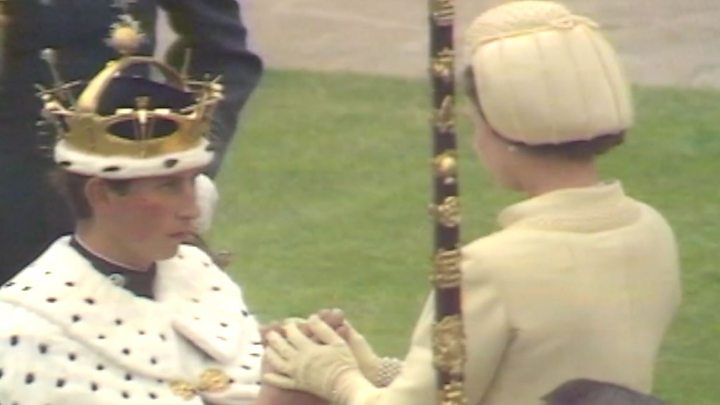Prince of Wales Investiture, Caernarfon Castle, 1969
“UPRIGHT, and youthful, he trod the path of history… “
So commented the television presenter amid the pomp and pageantry as Wales came to a virtual standstill on July 1, 1969, for the Investiture ceremony of Prince Charles as Prince of Wales, an event beamed across the nation from Caernarfon Castle in north Wales.
The investiture was watched by millions on television, and attracted large and excited crowds in Caernarfon, despite arousing considerable hostility among a minority of nationalist and republican Welsh people.
The Welsh borough of Swansea was granted city status to mark the occasion. Taught by Welsh-nationalist politician Edward Millward, 20-year-old Prince Charles spent 10 weeks leading up to his investiture learning about Welsh culture, history and language, and during the ceremony he gave his replies in both English and Welsh.

The investiture is a time-honoured ceremony marking formal acknowledgement of a newly-created Prince of Wales. During the investiture ceremony, the prince is presented and invested with the insignia of his rank and dignity, similar to a coronation. An investiture is purely ceremonial, as the title is created via letters patent.
The tradition of investing the heir apparent of the English, and subsequently the British, monarch with the title of Prince of Wales began in 1301, when King Edward I of England, having completed the conquest of Wales, gave the title to his heir apparent, Prince Edward (later King Edward II of England).
Investitures later fell into abeyance and the revival of investing the Prince of Wales in 1911, when the future King Edward VIII was invested in Caernarfon Castle, was largely due to David Lloyd George’s instigation. A similar ceremony was to be held in 1969 for Queen Elizabeth II’s son and heir, Prince Charles.
The ceremony in 1969 began with Prince Charles, led by the regalia bearers, entering the Chamberlain Tower, to await the arrival of Her Majesty. Once the royal family had arrived, the lesser members took their seats in the gallery, but the Queen and Duke of Edinburgh, led by the Earl of Snowdon, the Lord Great Chamberlain, the Earl Marshal and the Gentleman Usher carrying the Great Sword of State, made their way to the stage where the investiture was to be conducted.
After reaching the podium, where the Secretary of State for Wales, carrying the letters patent, was already standing, the Earl Marshal instructed Garter to conduct the Prince and his cortège from the tower. As they came to the stage Prince Charles knelt before the three thrones on the stage.
During the reading of the letters patent in Welsh, the Queen invested Charles with the girdle, sword, coronet, ring, rod and kingly mantle, in that order. Prince Charles then declared, “I, Charles, Prince of Wales, do become your liege man of life and limb and of earthly worship, and faith and truth I will bear unto thee, to live and die against all manner of folks.”
Charles then customarily kissed the Queen’s cheek and they embraced. Charles then took his place in the throne at his mother’s right, before standing to give two speeches, one in Welsh and one in English. A brief religious service was then conducted and the Queen led the Prince of Wales to Queen Eleanor’s Gate, to receive the homage of his adopted nation. The numerous banners and standards of the Prince of Wales were hung from the balcony.
The letters patent stated that Charles Philip Arthur George would receive the title, style, honour and privilege of the Principality of Wales and Earldom of Chester.
Some nationalists viewed the investiture as being associated with the subjugation of Welsh people since the 13th Century, when King Edward I of England deposed the last native Prince of Wales, Llywelyn ap Gruffudd.
The nationalist campaign against the investiture culminated with an attempted bombing by two members of the Mudiad Amddiffyn Cymru (Movement for the Defence of Wales). On the eve of the investiture two bombers were killed whilst placing a bomb outside government offices in Abergele.